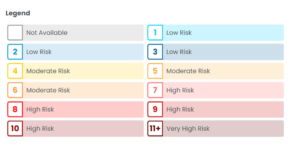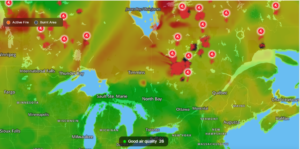Smoke events are situations where the air quality is affected by smoke, primarily from wildfires. While they can occur at any time of the year, typically they happen during wildfire season, which is April to October in Canada. Smoke events are more serious than regular air pollution due to the composition of the smoke. And for those with pre-existing health conditions such as heart or lung disease, or for the elderly, very young and pregnant women, they can be particularly serious.
Wildfire smoke is a complex mixture of what has burned. During wildfires, it’s not just trees that burn. Homes, industrial complexes and vehicles also burn, releasing additional toxins into the atmosphere. Smoke events are made up of gases, pollutants, sulphur dioxide, carbon monoxide, ozone, particles and fine particulate matter.
Air Quality
Air quality will vary depending on which way the wind is blowing and other weather conditions, as well as the intensity and size of the area(s) burning. Most weather reports include air quality as a parameter. It’s usually reported as AQI (Air Quality Index). In Canada, it’s measured on a scale from 1 – 11. Any rating of 3 or less is fine for outdoor activity for everyone, including those with health issues.
To find out more about air quality where you are, check out Wildfires in Canada%%The Weather Network.
Dangers of Smoke Events
Wildfire smoke can irritate your eyes, nose and throat. It can increase the risk of respiratory infections, worsen asthma and increase the risks of heart attack and stroke. High exposure to smoke events can result in long-term health implications.
Protecting Yourself
When the index is high, try to limit outdoor activity. To keep indoor air as clean as possible, keep windows and doors shut. If you turn on the air conditioning, use the recirculate setting. And clean or replace air conditioner and furnace filters. Don’t add to the air pollution in your home by burning candles, smoking or using gas fireplaces and stoves. Invest in a HEPA filter (you may need more than one depending on the volume of air it can recirculate) or an air purifier. If you have to priortize where to put them, locate them in infant and children’s bedrooms, or seniors bedrooms, and keep the door shut. If you don’t have the luxury of air conditioning, limit activity during the hotter parts of the day and consider spending some time in a cooler location, such as a mall or library.
If you plan on buying any air filters or healthcare products, it’s a good idea to purchase them before fire season starts.
As well, consider limiting the use of fans, bathroom and kitchen exhaust, and the drayer, to limit the outside air being drawn into your home to replace what is being evacuated.
For the same reason, in your car, use the recirculate setting on your air conditioning or heating. And consider replacing the air filter the next time you have your car serviced.
If you need to be outside, monitor the air quality and decide at what level the risk is too high. Where an N-95 mask, as it can filter out fine particles from the smoke. Bandanas and surgical masks are not as effective as an N-95 mask, but are better than nothing. And if you have trouble breathing, stop being outside altogether.
Eye drops can help with irritated and stinging eyes. Drink water to relieve an irritated throat.
Seek medical attention if you experience chest pain, shortness of breath or other symptoms of smoke inhalation. If you have underlying medical conditions, talk to your healthcare provider about a health action plan.
For more information on how to protect yourself outdoors, go to Strategies to Reduce Exposure Outdoors.
For more information on how to protect yourself indoors, go to Strategies to Reduce Exposure Indoors.
For more resources to to Fire Smoke Resources.
And lastly, visit www.airhealth.ca for more information on reducing health risks, how we contribute to pollution levels and for air quality health index information.
2Ascribe Inc. is a medical and dental transcription services agency located in Toronto, Ontario Canada, providing medical transcription services to physicians, specialists (including psychiatry, pain and IMEs), dentists, dental specialists, clinics and other healthcare providers across Canada. Our medical and dental transcriptionists take pride in the quality of your transcribed documents. WEBshuttle is our client interface portal for document management. 2Ascribe continues to implement and develop technology to assist and improve the transcription process for physicians, dentists and other healthcare providers, including AUTOfax. AUTOfax works within WEBshuttle to automatically send faxes to referring physicians and dentists when a document is e-signed by the healthcare professional. As a service to our clients and the healthcare industry, 2Ascribe offers articles of interest to physicians, dentists and other healthcare professionals, medical transcriptionists, dental transcriptionists and office staff, as well as of general interest. Additional articles may be found at http://www.2ascribe.com. For more information on Canadian transcription services, dental transcription, medical transcription work or dictation options, please contact us at info@2ascribe.com.


